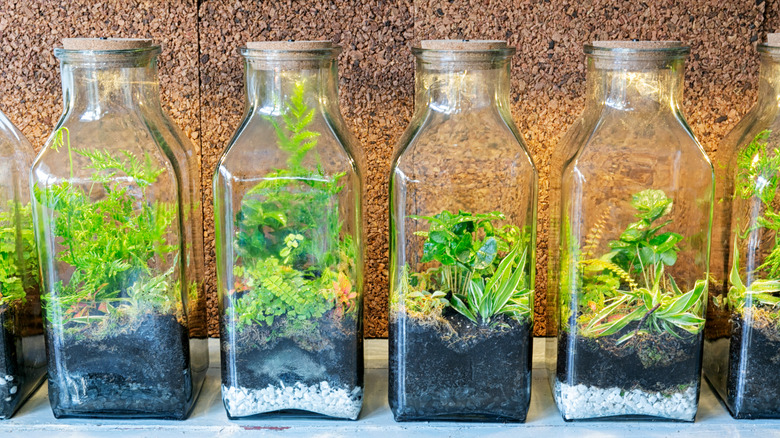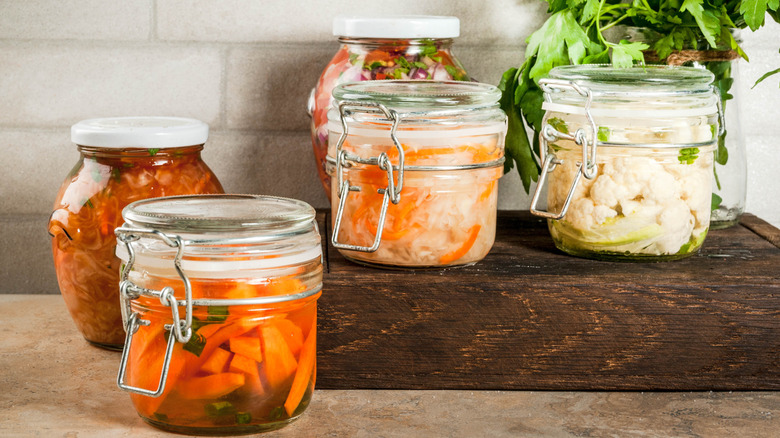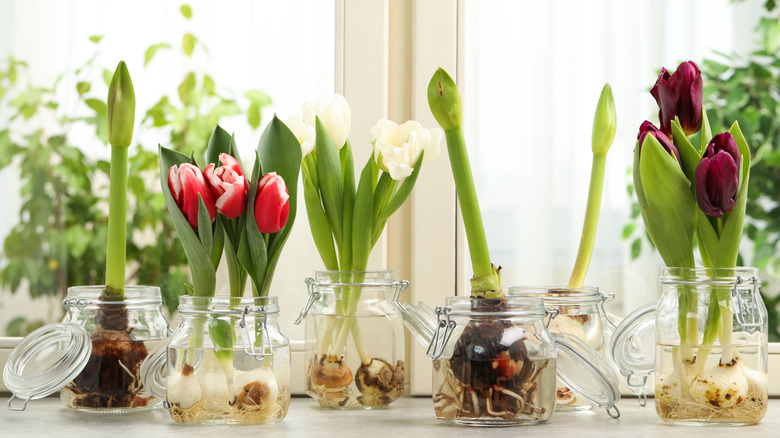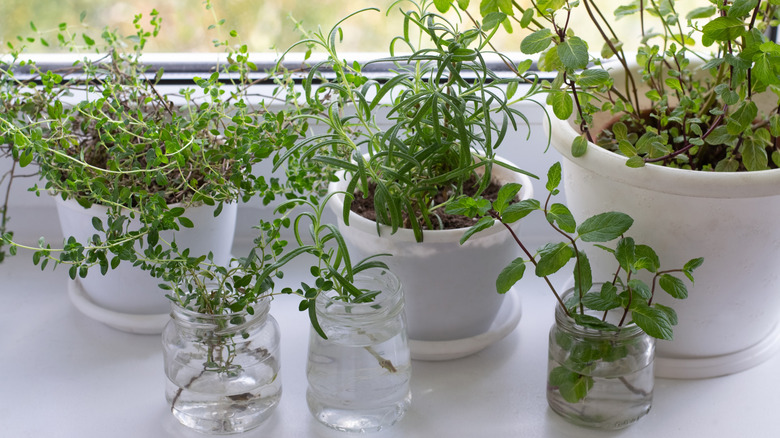10 Smart Ways To Repurpose Jars For Your Plants And Garden In The Winter
Although winter may keep many of us out of our gardens, it doesn't have to keep us from crafting and growing our plant-related passions. And that stash of jars in our cupboards can be just the thing to inspire cold weather projects. Let's call it two birds with one jar — repurpose an item that would otherwise be trashed or recycled, and use it to start something new. Our otherwise unneeded glass containers can be used to propagate, store, and grow when we're cooped up indoors.
Along with helping us keep our gardening hobbies alive during the dark, cold months of the year, reusing jars for fun, new projects can light a spark inside us that may end up lasting throughout the year. Whether you're trying one of these smart projects for the first time, or you're coming back to it after an absence, check your stash for jars that fill you with joy and inspire your creativity, to make these activities even more satisfying.
Bring branches indoors to make them flower
For those who can't wait for spring blooms but don't want to buy floral bouquets, there's another smart way to fill your home with blossoms — forcing branches to produce flowers. This process "wakes up" dormant branches by placing them in repurposed jars filled with water, in warm indoor temperatures that trick the plant into blooming early. Crab apples, willows, and redbuds from the garden make great options for forcing. However, it's important to take cuttings on mild winter days for this to work properly.
Creating tiny terrariums
Want to stay connected with nature in winter? You can make terrariums out of jars with tight fitting lids. These mini ecosystems create their own rain when condensation forms on the walls and lid, watering the soil. Use soilless growing medium covering layers of charcoal and gravel to create the ground in this enclosed world. Great vegetation choices for terrariums include ferns, baby's tears (Soleirolia soleirolii), nerve plant (Fittonia albivenis), and spikemosses (Selaginella spp.) – and choose a variety to keep things interesting. Keep the terrarium out of direct sunlight so you don't overheat its contents.
Fermenting garden produce
In fall, we harvest the remains of our gardens, and sometimes end up with a haul of produce that won't keep long at room temperatures. Fermentation is a smart way to preserve when you have too many perishable veggies. You can repurpose glass jars to ferment produce, making homemade lacto-fermented pickles, salsa, or sauerkraut for refreshing winter condiments. All you need is to keep the chopped or shredded contents covered in brine, and wait for the bacteria to work their acidifying magic. Fermentation time varies depending on the vegetable, but can be as quick as three days.
Forcing bulbs for winter blooms
Similar to making branches bloom indoors during the cold seasons, you can also force plant bulbs like amaryllis and paperwhites to flower in reused jars to which a layer of pebbles has been added, and partially filled with water. For amaryllis flowers, large jars are needed, though paperwhites can be grown in smaller sizes that are at least 2 inches deep. Add enough water so that the bulbs roots can reach it, but don't submerge the bulb or it will rot.
Growing sprouts for fresh meals
Throughout winter, sprouts can grow perfectly in your kitchen in repurposed jars. Use sterilized containers, mesh sprouting lids, and choose seeds packaged for sprouting, such as radish, alfalfa, or mung beans. Before you begin, soak the seeds in vinegar for 15 minutes, then rinse. Next, place them in water that's twice their volume, and soak in the jar for 12 to 16 hours. Rinse, then set the container on its side, and continue rinsing a few times a day. Depending on the type of seeds, you could have a harvest in just three days.
Keeping seeds for spring
If you're the type of gardener who has a lot of seeds on hand, keep in mind that you can reuse glass jars around your home for seed storage. Whether you're saving your own from garden flowers, herbs, and produce, or have indulged in some fun purchasing from seed catalogs, glass containers provide a smart way for you to protect your stash from mice and humidity all winter long. Consider adding repurposed silica packs inside the jar as well to prevent humidity problems, and store the filled jars in a cool, dry location.
Propagating houseplants from cuttings in water
If indoor plants are your jam, repurposed glass jars are great tools you can use to help you propagate cuttings like a pro for fun winter projects. There are so many different types of houseplants you can reproduce in this way, including pothos (Epipremnum aureum), inch plant (Tradescantia spp.), and Philodendron species. Make sure the cuttings you take have at least one node, and place the cutting in the jar so that at least one node is under water. These new specimens should be ready to pot in around three weeks.
Regrowing produce scraps
If you have a sunny windowsill, there's a smart way you can grow food in your kitchen during winter — by regrowing produce scraps in repurposed jars. When you keep your kitchen scraps, the plants you can regrow include celery, green onions, lettuce, and bok choy. With these four foods, the root end of the scrap is placed in a container filled with a few inches of water. Roots will start to grow in a few days and you can either keep growing them in water, or transplant to pots of soil.
Rooting cuttings of indoor herbs
Placing cuttings of fresh herbs from the garden or supermarket in repurposed jars of water will sustain your supply of fresh herbs in winter. You can use this smart technique to grow more plants for yourself or for gifts, since, just like houseplants, the stems can grow roots in water. Take cuttings that are 3 to 6 inches long, remove the bottom leaves from the stems, and place the bare stems in jars of water in indirect, bright light. Some of the herbs that root easiest in water are basil, mint, rosemary, and lemon verbena.
Storing dried herbs from the garden
If you've already done the hard work of cultivating herbs in your garden, once you harvest and dry your aromatic plants, repurposed glass jars make beautiful and smart ways to store and display them for delicious winter meals. Make sure the herbs are thoroughly dried out before packaging them with leaves whole rather than crushed, use airtight lids to ensure freshness, and place the containers of herbs in a cool, dark location to make them last longer.










